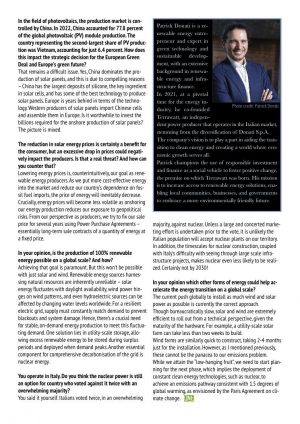 Patrick Donati is a renowned renewable energy expert and the founder of Terrawatt. In this interview with Only Natural Energy, Patrick shares insights on solar as an investment vehicle.
Patrick Donati is a renowned renewable energy expert and the founder of Terrawatt. In this interview with Only Natural Energy, Patrick shares insights on solar as an investment vehicle.
Terrawatt is one of the many spinoffs in the renewable energy business. How this company established in 2021 fits into the global international energy market?
Terrawatt is working to become an independent power producer (IPP) active in Italy and abroad. Currently, we have a development pipeline of c. 200mw, which we are working on bringing to authorisation. We aim to expand this pipeline to c. 500mw over the coming years and begin to convert these projects into operational solar farms, which provide clean energy to local communities and businesses.
What are the most reliable solutions you offer?
Terrawatt specialises in the development and construction of solar farms, which are an extremely dependable form of energy generation. Even with cloud cover, modern solar panels can generate energy from the available sunlight, and generally speaking, solar farms produce energy at the same time every day, with some fluctuations to account for seasonal shifts in sun hours. Furthermore, among all the benefits of solar panels, the energy produced does not require any additional emissions.
Is renewable energy a long-term financial investment?
Absolutely. Solar farms, wind farms, and hydro and biomass plants are classified as infrastructure assets with enduring and predictable cashflow profiles, making them excellent long-term investments. Once the renewable energy plant is built, it is expected to have a useful life of 20-30 years, with the potential for further extension through technological upgrades.
What do rising interest rates mean for renewable energy and for consumers?
Interest rates and energy prices are very closely linked macroeconomic elements. Energy, as an essential commodity, exhibits high price inelasticity – meaning that as prices rise, the decrease in demand is less than proportionate. Therefore, when energy prices surge, they often fuel a broader increase in inflation since energy is a key input across various economic sectors. Interest rate rises usually follow suit, which tend to have the effect of tempering new investments in the economy and stabilising inflationary trends.
How do rising interest rates impact solar projects?
Solar farms are typically built with a high leverage profile, which exposes their returns to fluctuations in interest rates. Resultantly the asset class is less attractive to potential investors, as interest payments and debt obligations constitute the number one cost components for solar farm operations.
What impact do they have on energy prices and the valuation of renewable energy? Do you think it is possible to mitigate this impact and how?
Energy prices tend to be dictated by the market rather than by producers. As an energy producer, there is not much to differentiate you from another producer of the same type. We all produce the same watts! Therefore, as interest rates rise, energy producers have their margins squeezed and valuations reduced. Given the nature of the market, it’s difficult for renewable producers to increase their sale prices because other producers will be able to sell the same energy at a lower price.
In the field of photovoltaics, the production market is controlled by China. In 2022, China accounted for 77.8 percent of the global photovoltaic (PV) module production. The country representing the second-largest share of PV production was Vietnam, accounting for just 6.4 percent. How does this impact the strategic decision for the European Green Deal and Europe’s green future?
That remains a difficult issue. Yes, China dominates the production of solar panels, and this is due to compelling reasons – China has the largest deposits of silicone, the key ingredient in solar cells, and has some of the best technology to produce solar panels. Europe is years behind in terms of the technology. Western producers of solar panels import Chinese cells and assemble them in Europe. Is it worthwhile to invest the billions required for the onshore production of solar panels? The picture is mixed.
The reduction in solar energy prices is certainly a benefit for the consumer, but an excessive drop in prices could negatively impact the producers. Is that a real threat? And how can you counter that?
Lowering energy prices is, counterintuitively, our goal as renewable energy producers. As we put more cost-effective energy into the market and reduce our country’s dependence on fossil fuel imports, the price of energy will inevitably decrease. Crucially, energy prices will become less volatile as onshoring our energy production reduces our exposure to geopolitical risks. From our perspective as producers, we try to fix our sale price for several years using Power Purchase Agreements – essentially long-term sale contracts of a quantity of energy at a fixed price.
In your opinion, is the production of 100% renewable energy possible on a global scale? And how?
Achieving that goal is paramount. But this won’t be possible with just solar and wind. Renewable energy sources harnessing natural resources are inherently unreliable – solar energy fluctuates with daylight availability, wind power hinges on wind patterns, and even hydroelectric sources can be affected by changing water levels worldwide. For a resilient electric grid, supply must constantly match demand to prevent blackouts and system damage. Hence, there’s a crucial need for stable, on-demand energy production to meet this fluctuating demand. One solution lies in utility-scale storage, allowing excess renewable energy to be stored during surplus periods and deployed when demand peaks. Another essential component for comprehensive decarbonisation of the grid is nuclear energy.
You operate in Italy. Do you think the nuclear power is still an option for country who voted against twice with an overwhelming majority?
You said it yourself. Italians voted twice, in an overwhelming majority, against nuclear. Unless a large and concerted marketing effort is undertaken prior to the vote, it is unlikely the Italian population will accept nuclear plants on our territory. In addition, the timescales for nuclear construction, coupled with Italy’s difficulty with seeing through large scale infrastructure projects, makes nuclear even less likely to be realized. Certainly not by 2030!
In your opinion which other forms of energy could help accelerate the energy transition on a global scale?
The current push globally to install as much wind and solar power as possible is currently the correct approach. Though bureaucratically slow, solar and wind are extremely efficient to roll out from a technical perspective, given the maturity of the hardware. For example, a utility-scale solar farm can take less than two weeks to build. Wind farms are similarly quick to construct, taking 2-4 months just for the installation. However, as I mentioned previously, these cannot be the panacea to our emissions problem. While we attain the “low-hanging fruit”, we need to start planning for the next phase, which implies the deployment of constant clean energy technologies, such as nuclear, to achieve an emissions pathway consistent with 1.5 degrees of global warming, as envisioned by the Paris Agreement on climate change.
Alice Masili


